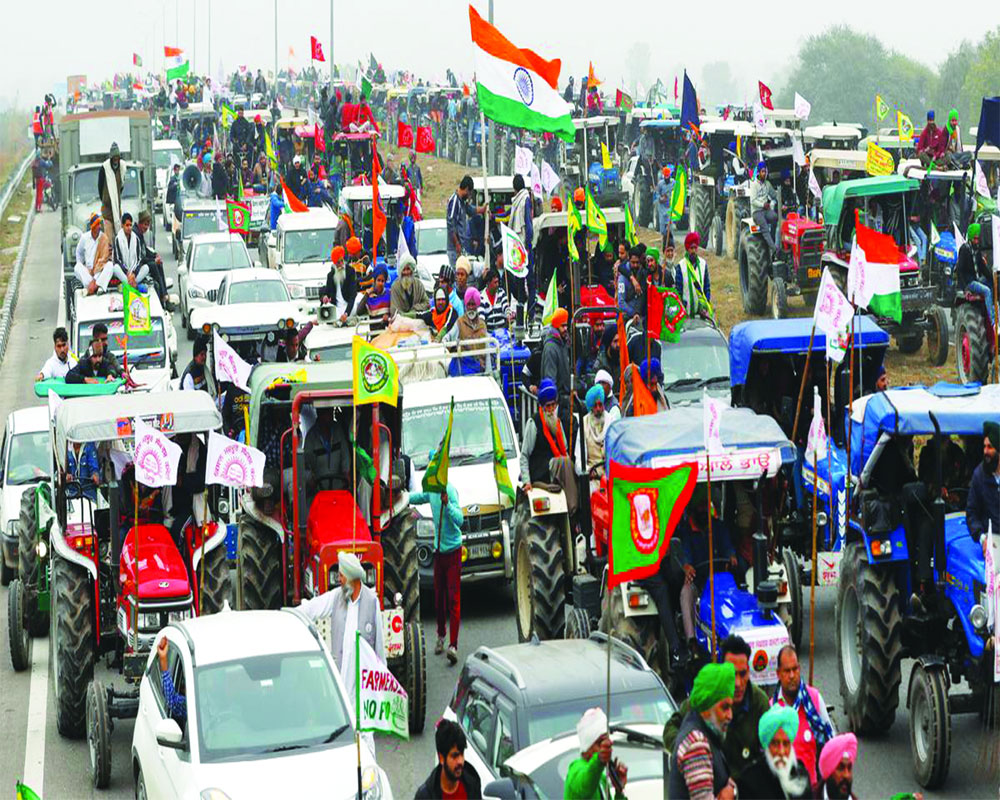The farmers’ protest that went out of hand on Republic Day reminds one of similar demonstrations in Bengal, especially in the pre-Independence era
The agitators had asked for a tractor rally on Republic Day last month. Most governments would have refused permission (as it was a day of constitutional celebration) and, perhaps, offered a date before or after January 26. To the delight of some agitators and to the surprise of others, the Government accepted the idea, subject to police discipline. No one, it would seem, suspected the dangers pregnant in the tractor tamasha, namely the hooligan babies and the enormity of the damage they could lead to the cause. The day witnessed the worst rioting one could have seen or imagined except that not a drop of blood was shed; one death was of a tractor driver involved in an accident. For the farmers, the rally was the low point of their two-month struggle for the cause as demonstrated on the chilly highways around Delhi. For the Government, it was an unexpected bonanza.
Only the Left Front could enact comedy on the streets of Calcutta (now Kolkata) whenever its ruling Government called a protest bandh, against whom no one knew, although it was impeccably enforced. Not a bird flew near any of the many streets in the city. Press was free to move, so I moved about; the boys at street corners guarding the bandh were often keen to be interviewed and photographed.
It was a comedy for all those citizens who enjoyed a holiday but a sarco-comedy for the poor in the unorganised sector. The rickshawalas, taxi drivers, bus operators, mutias or coolies et al had to go without wages. When I asked a boy at a street corner about it, his reply was that these men do not belong to our unions, what do we owe them? Working class was an expression too distant for the boy.
The most tragic rioting that Calcutta ever witnessed was between August 16 and 18, 1946. It was an attempt by MA Jinnah to convince London that Hindus and Muslims could not coexist, hence the Partition. I quote briefly from the official letter of the Bengal Governor to the Secretary of State:
“The scale of rioting was unprecedented. It was a pogrom between two rival armies of the Calcutta underworld. The fact that over 2,000 persons of the goonda type who had been confined under the Defence of India Rules during the war were released the previous year is of great significance. The only thing which prevented a complete collapse of the administration was the three battalions of British troops, who were readily available for this sort of emergency. Though the occasion and nature of the emergency could not be foreseen, the Army Commander and I had long agreed on the necessity of such a disposition of troops. I could not possibly have held Calcutta with the police alone, and I am doubtful if Indian troops would have inspired sufficient confidence. That the infection did not spread immediately to the districts is a fact for which we cannot be too thankful. We had to take a big chance in denuding Howrah and the mill areas of troops on the 17th.
The obligations of the Constitution made my task far harder. My special responsibility for law and order is not a ‘discretionary’ matter and, in handling the situation, particularly at the outset, I had always to consider the susceptibilities of my Ministry. The dual personality of Suhrawardy, as Chief Minister (in charge of the Home portfolio) and as the most influential member of the Muslim League in Bengal, was a constant embarrassment.
Yours sincerely,
FJ Burrows
CC: Lord Wavell, Viceroy”
What was an even more tragic event, although bloodlessly, was the partition of Bengal in 1905. The idea was not new, it was bubbling since, say, 1875. By dividing Bengal on communal lines and encouraging Muslim ascendancy in the east, the Government was, in Risley’s words, weakening “a solid body of opponents” to the Raj. Viceroy Curzon was presented with hundreds of petitions, which he chose to ignore. Bengal united is a power; Bengal divided will pull several different ways. The summer of 1905 was a long, hot one in Bengal and the atmosphere was charged with tension. The editor of a leading daily had condemned the partition. Overnight, emotions had risen to fever pitch. People refused to participate in festivities where foreign salt or sugar was used. The giant was stirring and even the Viceroy was forced to admit “the spectacle that has been presented by the streets of Calcutta during the past fortnight has not in my opinion been creditable to the Capital of a great Empire”.
October 16, the day of the tragedy, became a turning point in British India’s history. The announcement of partition shattered the long, legendary belief in the eventual fairness of the British. It became a day of national mourning. No food was cooked in Calcutta’s homes, the domestic hearths remained unlit. Shops and offices were closed and, in several places, newspapers were not distributed. Poet Rabindranath’s song, “Banglar mati Banglar jal”, thrilled patriotic sentiments to an all-time high and the ball had been set rolling for a mass Raksha Bandhan ceremony. Virtual strangers stopped each other on the streets to tie the rakhi thread, symbolising brotherhood.
(The writer is a well-known columnist and an author. The views expressed are personal.)


























